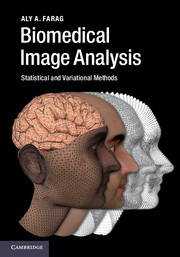Book contents
- Frontmatter
- Dedication
- Contents
- Preface
- Nomenclature
- 1 Overview of biomedical image analysis
- Part I Signals and systems, image formation, and image modality
- Part II Stochastic models
- 4 Random variables
- 5 Random processes
- 6 Basics of random fields
- 7 Probability density estimation by linear models
- Part III Computational geometry
- Part IV Variational approaches and level sets
- Part V Image analysis tools
- Index
- References
7 - Probability density estimation by linear models
from Part II - Stochastic models
Published online by Cambridge University Press: 05 November 2014
- Frontmatter
- Dedication
- Contents
- Preface
- Nomenclature
- 1 Overview of biomedical image analysis
- Part I Signals and systems, image formation, and image modality
- Part II Stochastic models
- 4 Random variables
- 5 Random processes
- 6 Basics of random fields
- 7 Probability density estimation by linear models
- Part III Computational geometry
- Part IV Variational approaches and level sets
- Part V Image analysis tools
- Index
- References
Summary
Probability density estimation is a crucial step in stochastic system identification. In the random field models studied in Chapter 6 as well as the applications to follow in image analysis, probability density estimation is a fundamental component. The purpose of this chapter is to study approaches for density estimation that are local, i.e. may be identified using empirical measurements, which are assumed realizations of a random process or random field of a certain statistical experiment. Of interest to us are density models that have manageable numerical implementation and may be used at various levels of image analysis.
Introduction
Numerical methods for estimating the probability density function (PDF) of a random variable X (a random vector in general) are important in various signal and image analysis applications. Such estimates form the basis of optimal filtering, synthesis, and segmentation of an image or a signal. Indeed, PDF estimation is fundamental in Bayesian statistics and in a huge number of machine-learning applications [7.1].
Information
- Type
- Chapter
- Information
- Biomedical Image AnalysisStatistical and Variational Methods, pp. 163 - 180Publisher: Cambridge University PressPrint publication year: 2014
